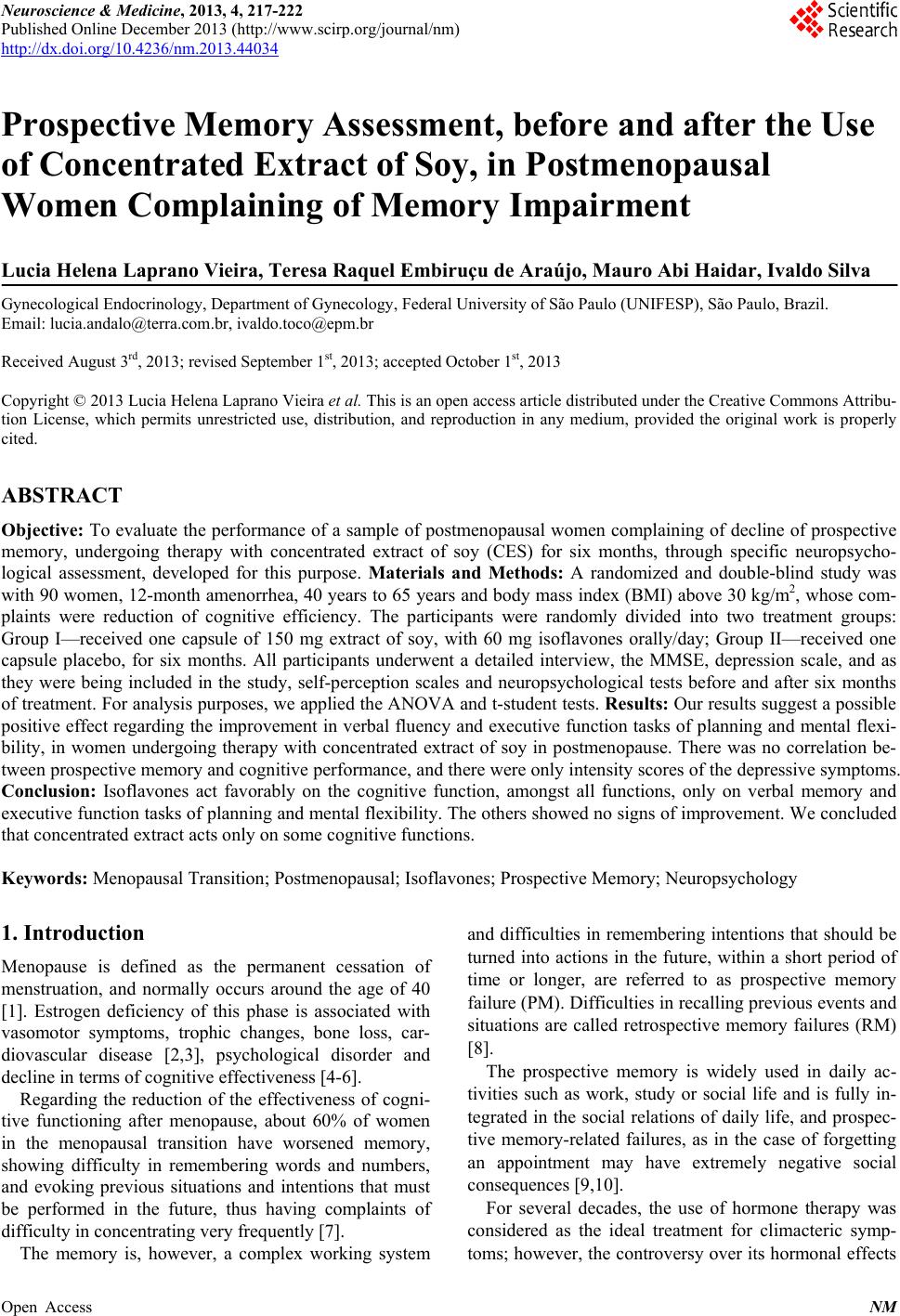 Neuroscience & Medicine, 2013, 4, 217-222 Published Online December 2013 (http://www.scirp.org/journal/nm) http://dx.doi.org/10.4236/nm.2013.44034 Open Access NM 217 Prospective Memory Assessment, before and after the Use of Concentrated Extract of Soy, in Postmenopausal Women Complaining of Memory Impairment Lucia Helena Laprano Vieira, Teresa Raquel Embiruçu de Araújo, Mauro Abi Haidar, Ivaldo Silva Gynecological Endocrinology, Department of Gynecology, Federal University of São Paulo (UNIFESP), São Paulo, Brazil. Email: lucia.andalo@terra.com.br, ivaldo.toco@epm.br Received August 3rd, 2013; revised September 1st, 2013; accepted October 1st, 2013 Copyright © 2013 Lucia Helena Laprano Vieira et al. This is an open access article distributed under the Creative Commons Attribu- tion License, which permits unrestricted use, distribution, and reproduction in any medium, provided the original work is properly cited. ABSTRACT Obje ctive: To evaluate the performance of a sample of postmenopausal women complaining of decline of prospective memory, undergoing therapy with concentrated extract of soy (CES) for six months, through specific neuropsycho- logical assessment, developed for this purpose. Materials and Methods: A randomized and double-blind study was with 90 women, 12-month amenorrhea, 40 years to 65 years and body mass index (BMI) above 30 kg/m2, whose com- plaints were reduction of cognitive efficiency. The participants were randomly divided into two treatment groups: Group I—received one capsule of 150 mg extract of soy, with 60 mg isoflavones orally/day; Group II—received one capsule placebo, for six months. All participants underwent a detailed interview, the MMSE, depression scale, and as they were being included in the study, self-perception scales and neuropsychological tests before and after six months of treatment. For analysis purposes, we applied the ANOVA and t-student tests. Results: Our results suggest a possible positive effect regarding the improvement in verbal fluency and executive function tasks of planning and mental flexi- bility, in women undergoing therapy with concentrated extract of soy in postmenopause. There was no correlation be- tween prospective memory and cognitive performance, and there were only intensity scores of the depressive symptoms. Conclusion: Isoflavones act favorably on the cognitive function, amongst all functions, only on verbal memory and executive function tasks of planning and mental flexibility. The others showed no signs of improvement. We concluded that concentrated extract acts only on some cognitive functions. Keywords: Menopausal Transition; Postmenopausal; Isoflavones; Prospective Memory; Neuropsychology 1. Introduction Menopause is defined as the permanent cessation of menstruation, and normally occurs around the age of 40 [1]. Estrogen deficiency of this phase is associated with vasomotor symptoms, trophic changes, bone loss, car- diovascular disease [2,3], psychological disorder and decline in terms of cognitive effectiveness [4-6]. Regarding the reduction of the effectiveness of cogni- tive functioning after menopause, about 60% of women in the menopausal transition have worsened memory, showing difficulty in remembering words and numbers, and evoking previous situations and intentions that must be performed in the future, thus having complaints of difficulty in concentrating very frequently [7]. The memory is, however, a complex working system and difficulties in remembering intentions that should be turned into actions in the future, within a short period of time or longer, are referred to as prospective memory failure (PM). Difficulties in recalling previous events and situations are called retrospective memory failures (RM) [8]. The prospective memory is widely used in daily ac- tivities such as work, study or social life and is fully in- tegrated in the social relations of daily life, and prospec- tive memory-related failures, as in the case of forgetting an appointment may have extremely negative social consequences [9,10]. For several decades, the use of hormone therapy was considered as the ideal treatment for climacteric symp- toms; however, the controversy over its hormonal effects 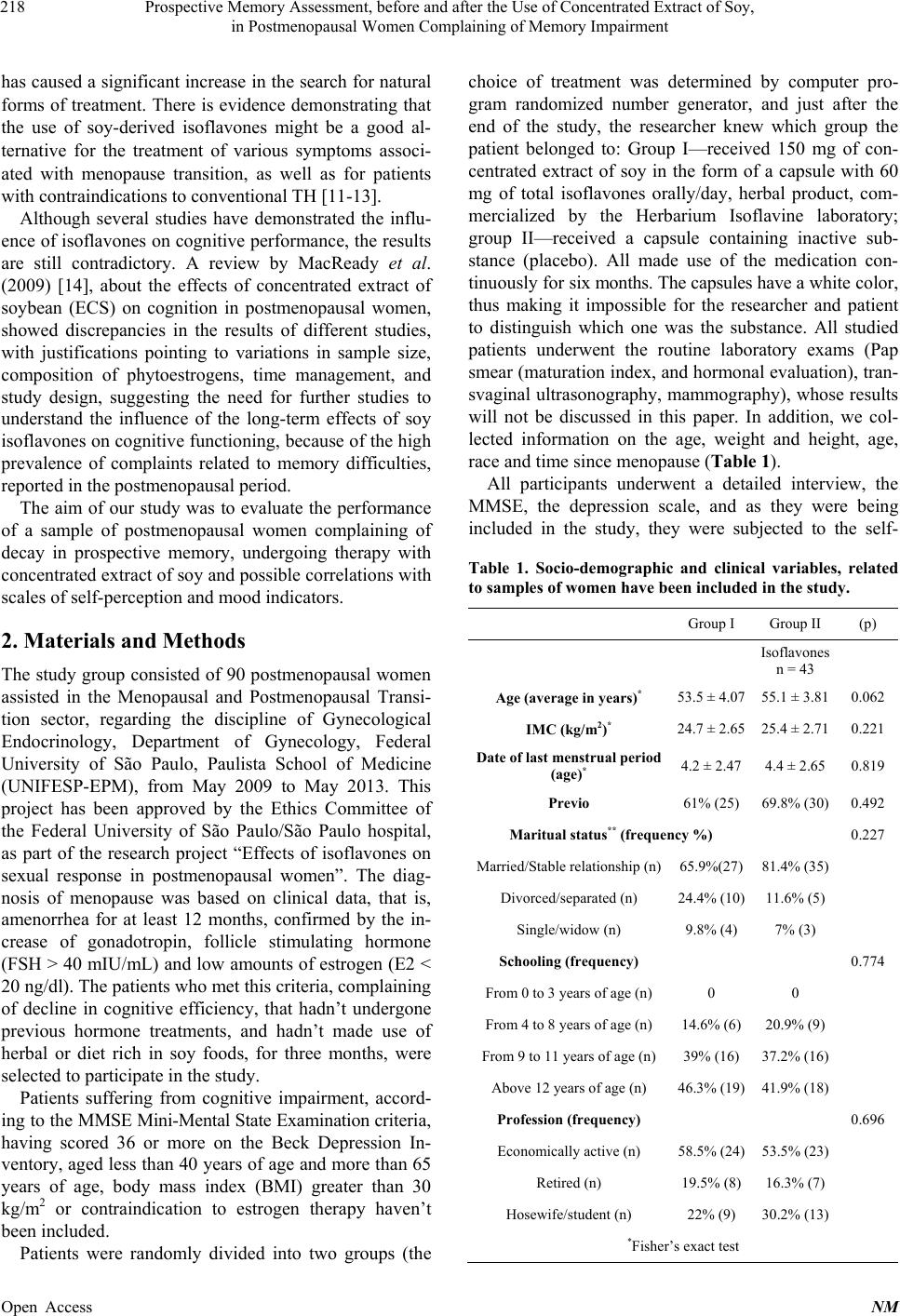 Prospective Memory Assessment, before and after the Use of Concentrated Extract of Soy, in Postmenopausal Women Complaining of Memory Impairment 218 has caused a significant increase in the search for natural forms of treatment. There is evidence demonstrating that the use of soy-derived isoflavones might be a good al- ternative for the treatment of various symptoms associ- ated with menopause transition, as well as for patients with contraindications to conventional TH [11-13]. Although several studies have demonstrated the influ- ence of isoflavones on cognitive performance, the results are still contradictory. A review by MacReady et al. (2009) [14], about the effects of concentrated extract of soybean (ECS) on cognition in postmenopausal women, showed discrepancies in the results of different studies, with justifications pointing to variations in sample size, composition of phytoestrogens, time management, and study design, suggesting the need for further studies to understand the influence of the long-term effects of soy isoflavones on cognitive functioning, because of the high prevalence of complaints related to memory difficulties, reported in the postmenopausal period. The aim of our study was to evaluate the performance of a sample of postmenopausal women complaining of decay in prospective memory, undergoing therapy with concentrated extract of soy and possible correlations with scales of self-perception and mood indicators. 2. Materials and Methods The study group consisted of 90 postmenopausal women assisted in the Menopausal and Postmenopausal Transi- tion sector, regarding the discipline of Gynecological Endocrinology, Department of Gynecology, Federal University of São Paulo, Paulista School of Medicine (UNIFESP-EPM), from May 2009 to May 2013. This project has been approved by the Ethics Committee of the Federal University of São Paulo/São Paulo hospital, as part of the research project “Effects of isoflavones on sexual response in postmenopausal women”. The diag- nosis of menopause was based on clinical data, that is, amenorrhea for at least 12 months, confirmed by the in- crease of gonadotropin, follicle stimulating hormone (FSH > 40 mIU/mL) and low amounts of estrogen (E2 < 20 ng/dl). The patients who met this criteria, complaining of decline in cognitive efficiency, that hadn’t undergone previous hormone treatments, and hadn’t made use of herbal or diet rich in soy foods, for three months, were selected to participate in the study. Patients suffering from cognitive impairment, accord- ing to the MMSE Mini-Mental State Examination criteria, having scored 36 or more on the Beck Depression In- ventory, aged less than 40 years of age and more than 65 years of age, body mass index (BMI) greater than 30 kg/m2 or contraindication to estrogen therapy haven’t been included. Patients were randomly divided into two groups (the choice of treatment was determined by computer pro- gram randomized number generator, and just after the end of the study, the researcher knew which group the patient belonged to: Group I—received 150 mg of con- centrated extract of soy in the form of a capsule with 60 mg of total isoflavones orally/day, herbal product, com- mercialized by the Herbarium Isoflavine laboratory; group II—received a capsule containing inactive sub- stance (placebo). All made use of the medication con- tinuously for six months. The capsules have a white color, thus making it impossible for the researcher and patient to distinguish which one was the substance. All studied patients underwent the routine laboratory exams (Pap smear (maturation index, and hormonal evaluation), tran- svaginal ultrasonography, mammography), whose results will not be discussed in this paper. In addition, we col- lected information on the age, weight and height, age, race and time since menopause (Table 1). All participants underwent a detailed interview, the MMSE, the depression scale, and as they were being included in the study, they were subjected to the self- Table 1. Socio-demographic and clinical variables, related to samples of women have been included in the study . Group I Group II (p) Isoflavones n = 43 Age (average in years)* 53.5 ± 4.07 55.1 ± 3.810.062 IMC (kg/m2)* 24.7 ± 2.65 25.4 ± 2.710.221 Date of last menstrual period (age)* 4.2 ± 2.47 4.4 ± 2.650.819 Previo 61% (25) 69.8% (30)0.492 Maritual status** (frequency %) 0.227 Married/Stable relationship (n) 65.9%(27) 81.4% (35) Divorced/separated (n) 24.4% (10) 11.6% (5) Single/widow (n) 9.8% (4) 7% (3) Schooling (frequency) 0.774 From 0 to 3 years of age (n) 0 0 From 4 to 8 years of age (n) 14.6% (6) 20.9% (9) From 9 to 11 years of age (n)39% (16) 37.2% (16) Above 12 years of age (n) 46.3% (19) 41.9% (18) Profession (frequency) 0.696 Economically active (n) 58.5% (24) 53.5% (23) Retired (n) 19.5% (8) 16.3% (7) Hosewife/student (n) 22% (9) 30.2% (13) *Fisher’s exact test Open Access NM 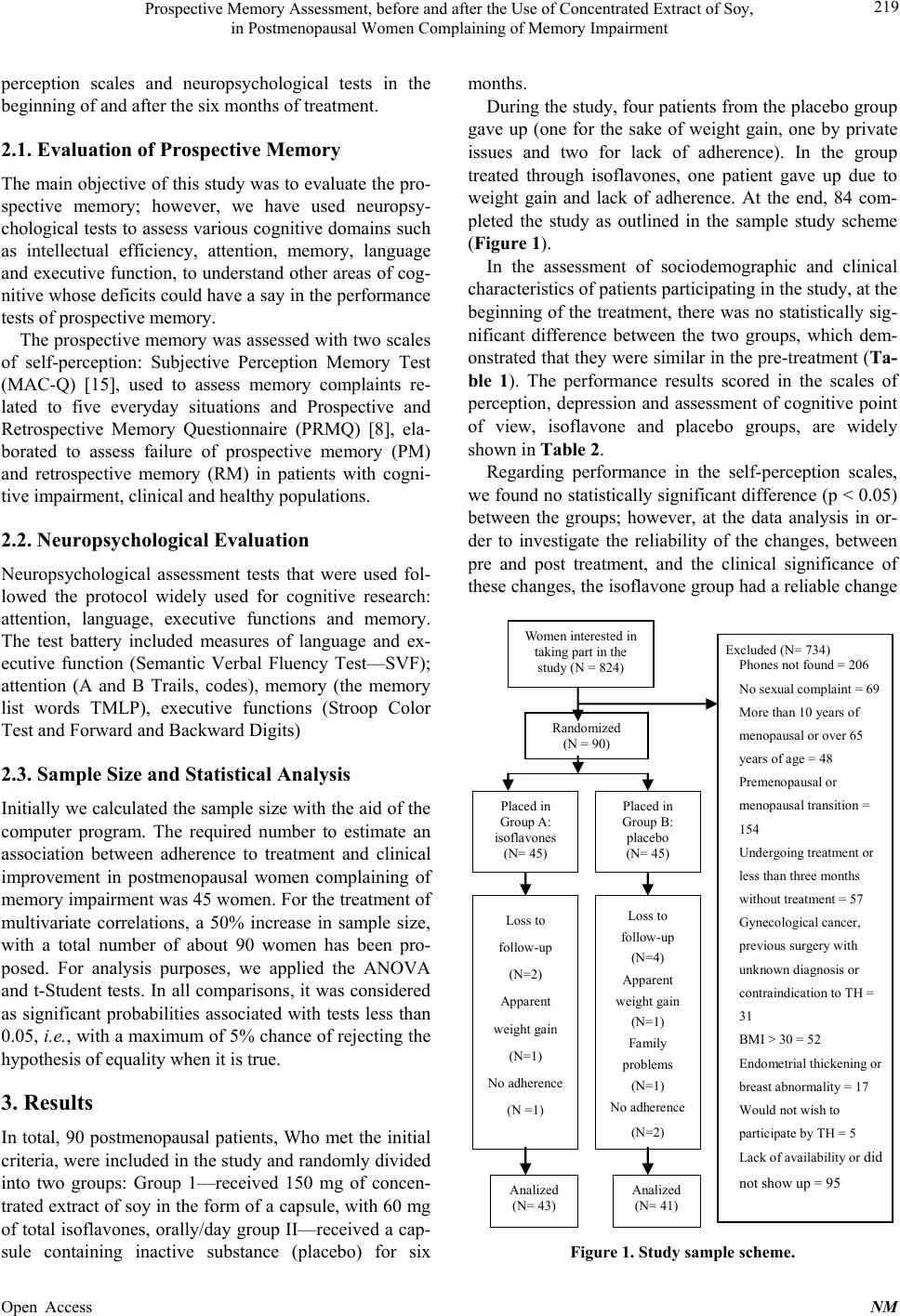 Prospective Memory Assessment, before and after the Use of Concentrated Extract of Soy, in Postmenopausal Women Complaining of Memory Impairment 219 perception scales and neuropsychological tests in the beginning of and after the six months of treatment. 2.1. Evaluation of Prospective Memory The main objective of this study was to evaluate the pro- spective memory; however, we have used neuropsy- chological tests to assess various cognitive domains such as intellectual efficiency, attention, memory, language and executive function, to understand other areas of cog- nitive whose deficits could have a say in the performance tests of prospective memory. The prospective memory was assessed with two scales of self-perception: Subjective Perception Memory Test (MAC-Q) [15], used to assess memory complaints re- lated to five everyday situations and Prospective and Retrospective Memory Questionnaire (PRMQ) [8], ela- borated to assess failure of prospective memory (PM) and retrospective memory (RM) in patients with cogni- tive impairment, clinical and healthy populations. 2.2. Neuropsychological Evaluation Neuropsychological assessment tests that were used fol- lowed the protocol widely used for cognitive research: attention, language, executive functions and memory. The test battery included measures of language and ex- ecutive function (Semantic Verbal Fluency Test—SVF); attention (A and B Trails, codes), memory (the memory list words TMLP), executive functions (Stroop Color Test and Forward and Backward Digits) 2.3. Sample Size and Statistical Analysis Initially we calculated the sample size with the aid of the computer program. The required number to estimate an association between adherence to treatment and clinical improvement in postmenopausal women complaining of memory impairment was 45 women. For the treatment of multivariate correlations, a 50% increase in sample size, with a total number of about 90 women has been pro- posed. For analysis purposes, we applied the ANOVA and t-Student tests. In all comparisons, it was considered as significant probabilities associated with tests less than 0.05, i.e., with a maximum of 5% chance of rejecting the hypothesis of equality when it is true. 3. Results In total, 90 postmenopausal patients, Who met the initial criteria, were included in the study and randomly divided into two groups: Group 1—received 150 mg of concen- trated extract of soy in the form of a capsule, with 60 mg of total isoflavones, orally/day group II—received a cap- sule containing inactive substance (placebo) for six months. During the study, four patients from the placebo group gave up (one for the sake of weight gain, one by private issues and two for lack of adherence). In the group treated through isoflavones, one patient gave up due to weight gain and lack of adherence. At the end, 84 com- pleted the study as outlined in the sample study scheme (Figure 1). In the assessment of sociodemographic and clinical characteristics of patients participating in the study, at the beginning of the treatment, there was no statistically sig- nificant difference between the two groups, which dem- onstrated that they were similar in the pre-treatment (Ta- ble 1). The performance results scored in the scales of perception, depression and assessment of cognitive point of view, isoflavone and placebo groups, are widely shown in Table 2. Regarding performance in the self-perception scales, we found no statistically significant difference (p < 0.05) between the groups; however, at the data analysis in or- der to investigate the reliability of the changes, between pre and post treatment, and the clinical significance of these changes, the isoflavone group had a reliable change Randomized N=90 Loss to follow-up (N=2) Apparent weight gain (N=1) No adherence (N =1) Loss to follow-up (N=4) Apparent weight gain (N=1) Family problems (N=1) No adherence (N=2) Analized (N= 43) Excluded (N= 734) Phones not found = 206 No sexual complaint = 69 More than 10 years of menopausal or over 65 years of age = 48 Premenopausal or menopausal transition = 154 Undergoing treatment or less than three months without treatment = 57 Gynecological cancer, previous surgery with unknown diagnosis or contraindication to TH = 31 BMI > 30 = 52 Endometrial thickening or breast abnormality = 17 Would not wish to participate by TH = 5 Lack of availability or did not show up = 95 Analized (N= 41) Placed in Group B: placebo (N= 45) Placed in Group A: isoflavones (N= 45) Women interested in taking part in the study (N = 824) Figure 1. Study sample sc he me. Open Access NM  Prospective Memory Assessment, before and after the Use of Concentrated Extract of Soy, in Postmenopausal Women Complaining of Memory Impairment 220 Table 2. Summary of the overall results of the study of the placebo groups and isoflavones at the first visit (pretreat- ment) and after 6 months of treatment. placebo Isoflavonevalue p* BDI −6.2 (11.28) −7.8 (10.10)0.486 MAC-Q −2.3 (15.46) −7.3 (17.94)0.172 OVERALL TOTAL PRMQ −2.9 (15.94) −7.3 (18.74)0.250 TRAIL A (seconds) −6.7 (15.82) −2.8 (21.07)0.340 TRAIL B (seconds) −10.0 (27.28) −8.4 (50.91)0.852 STROOP I −1.4 (6.95) −3.6 (7.00)0.146 STROOP II −2.2 (5.85) −1.5 (7.78)0.663 STROOP III −4.8 (10.82) −4.1 (9.20)0.891 LIST OF WORDS (Total) 6.7 (11.69) 5.9 (11.88)0.764 CODES 2.4 (6.66) 2.5 (5.48)0.973 OD Digits −0.9 (11.43) −5.6 (13.00)0.078 OI Digits −2.0 (14.76) −0.6 (15.04)0.657 TOTAL OF Digits −1.4 (8.37) −3.3 (8.98)0.319 VERBAL FLUENCY 0.3 (2.48) 1.3 (1.72)0.027* *comparison between groups in the scale of self-reported failures of prospective mem- ory (p = 0.027) (Figure 2). In the group of isoflavones there was no statistically significant difference (p < 0.05) between prospective memory and performance on neuropsychological tests of controls: Track A (p = 0.340), Track B (p = 0.852), word list (p = 0.764), Codes subtest (p = 0.973), Stroop I (p = 0.146), Stroop II (p = 0.663), Stroop III (p = 0.891), To- tal Digits Forward and Backward (p = 0.319). In the ver- bal fluency test that assesses processing of language and executive function, the isoflavone group had better per- formance when compared to the control group. (p = 0.027). The correlation of the scales of self-perception (MAC- Q, MP and MR) with neuropsychological tests was sta- tistically weak, however there was a positive correlation between the scale that assesses the severity of Beck de- pressive symptoms with the scale of self-perception PRMQ in Total (p = 0.001), mp (p = 0.002), and MR (p ≤ 0.001). 4. Discussion This study aimed at analyzing the effects of the concen- trated extract of soy in the perception of prospective memory, after menopause. We know that cognitive de- cline is very common in the transition and postmeno- Figure 2. Reliability of the pre- and post-intervention changes on the self-reported prospective memory failures scale. pause. Several theories attempting to explain the retarda- tion appeared through that stage, and the more likely is the one regarding the reduction of the levels of estrogens, by changing some neurotransmitters and synaptic density in key areas of the central nervous system (CNS) [16]. Investigations on the effects of HT on cognitive func- tioning revealed positive effects, particularly in verbal memory, verbal fluency, concentration, attention and speed of information processing [17,18]. Our results partially confirm these data and suggest a possible positive effect of isoflavones regarding greater verbal fluency and executive function tasks of planning and mental flexibility, in women undergoing therapy with concentrated extract of soy in postmenopausal. Our sample showed some important characteristics, such as an average age of 55 years, which can be indi- cated as a negative factor, since it excludes the possibil- ity of research into the effect of age and frequency of memory failures; however, results reported by Hachul et al. (2009) [19] reported that patients in the early post- menopausal period claimed to have more memory fail- ures compared to women in pre-menopause and during the late postmenopause. Possibly, these subjective mem- ory difficulties reflect a greater perception of cognitive performance that was strongly reflected in the average age of our sample. Another important demographic characteristic was the average schooling, mostly 9 to 11 years and above 12 years, as well as the highest percentage regarding profes- sions: economically active patients. According to De Lorenzi et al. (2006) [20] as they approach menopause, women bring questions about the physical changes that Open Access NM 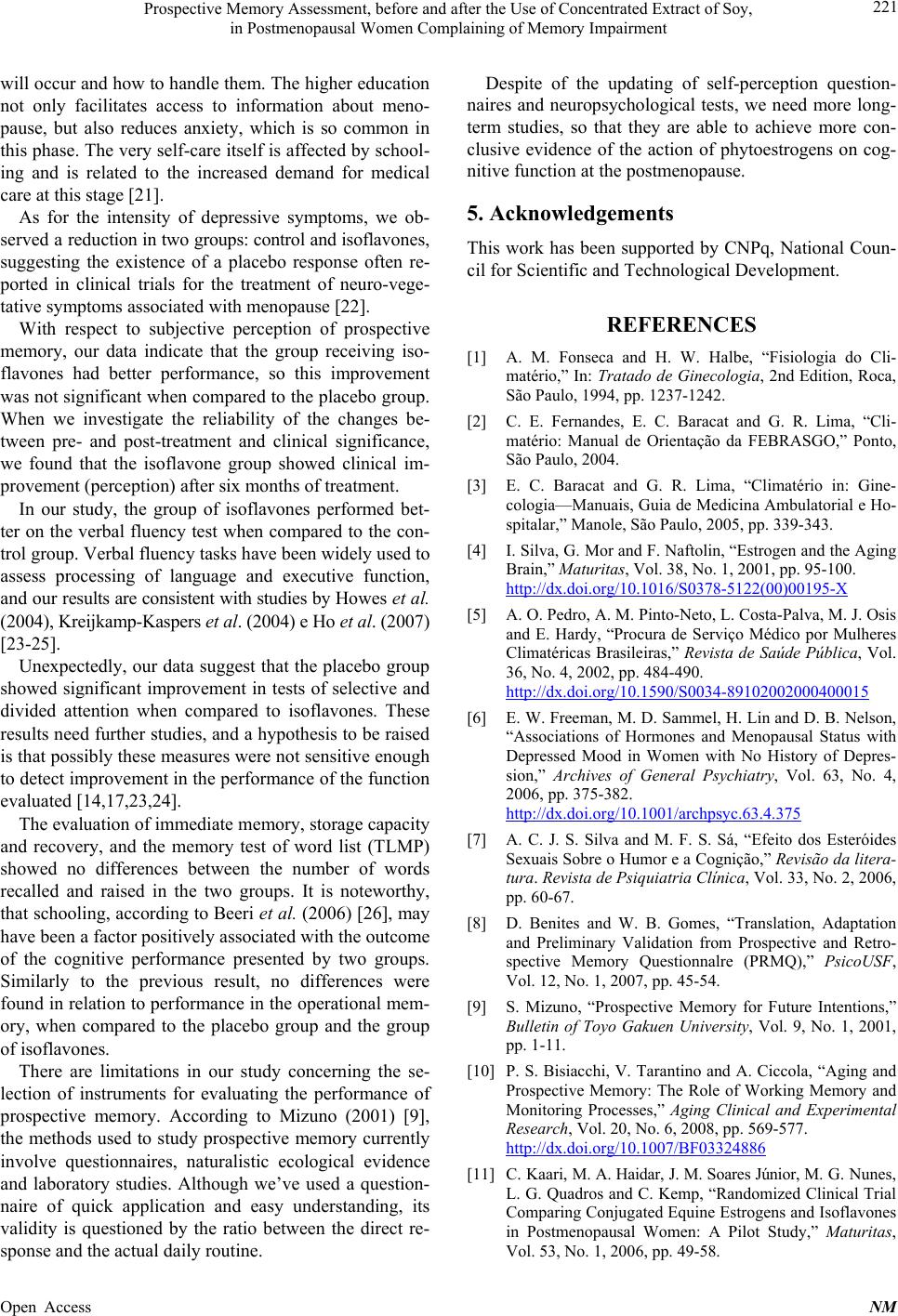 Prospective Memory Assessment, before and after the Use of Concentrated Extract of Soy, in Postmenopausal Women Complaining of Memory Impairment 221 will occur and how to handle them. The higher education not only facilitates access to information about meno- pause, but also reduces anxiety, which is so common in this phase. The very self-care itself is affected by school- ing and is related to the increased demand for medical care at this stage [21]. As for the intensity of depressive symptoms, we ob- served a reduction in two groups: control and isoflavones, suggesting the existence of a placebo response often re- ported in clinical trials for the treatment of neuro-vege- tative symptoms associated with menopause [22]. With respect to subjective perception of prospective memory, our data indicate that the group receiving iso- flavones had better performance, so this improvement was not significant when compared to the placebo group. When we investigate the reliability of the changes be- tween pre- and post-treatment and clinical significance, we found that the isoflavone group showed clinical im- provement (perception) after six months of treatment. In our study, the group of isoflavones performed bet- ter on the verbal fluency test when compared to the con- trol group. Verbal fluency tasks have been widely used to assess processing of language and executive function, and our results are consistent with studies by Howes et al. (2004), Kreijkamp-Kaspers et al. (2004) e Ho et al. (2007) [23-25]. Unexpectedly, our data suggest that the placebo group showed significant improvement in tests of selective and divided attention when compared to isoflavones. These results need further studies, and a hypothesis to be raised is that possibly these measures were not sensitive enough to detect improvement in the performance of the function evaluated [14,17,23,24]. The evaluation of immediate memory, storage capacity and recovery, and the memory test of word list (TLMP) showed no differences between the number of words recalled and raised in the two groups. It is noteworthy, that schooling, according to Beeri et al. (2006) [26], may have been a factor positively associated with the outcome of the cognitive performance presented by two groups. Similarly to the previous result, no differences were found in relation to performance in the operational mem- ory, when compared to the placebo group and the group of isoflavones. There are limitations in our study concerning the se- lection of instruments for evaluating the performance of prospective memory. According to Mizuno (2001) [9], the methods used to study prospective memory currently involve questionnaires, naturalistic ecological evidence and laboratory studies. Although we’ve used a question- naire of quick application and easy understanding, its validity is questioned by the ratio between the direct re- sponse and the actual daily routine. Despite of the updating of self-perception question- naires and neuropsychological tests, we need more long- term studies, so that they are able to achieve more con- clusive evidence of the action of phytoestrogens on cog- nitive function at the postmenopause. 5. Acknowledgements This work has been supported by CNPq, National Coun- cil for Scientific and Technological Development. REFERENCES [1] A. M. Fonseca and H. W. Halbe, “Fisiologia do Cli- matério,” In: Tratado de Ginecologia, 2nd Edition, Roca, São Paulo, 1994, pp. 1237-1242. [2] C. E. Fernandes, E. C. Baracat and G. R. Lima, “Cli- matério: Manual de Orientação da FEBRASGO,” Ponto, São Paulo, 2004. [3] E. C. Baracat and G. R. Lima, “Climatério in: Gine- cologia—Manuais, Guia de Medicina Ambulatorial e Ho- spitalar,” Manole, São Paulo, 2005, pp. 339-343. [4] I. Silva, G. Mor and F. Naftolin, “Estrogen and the Aging Brain,” Maturitas, Vol. 38, No. 1, 2001, pp. 95-100. http://dx.doi.org/10.1016/S0378-5122(00)00195-X [5] A. O. Pedro, A. M. Pinto-Neto, L. Costa-Palva, M. J. Osis and E. Hardy, “Procura de Serviço Médico por Mulheres Climatéricas Brasileiras,” Revista de Saúde Pública, Vol. 36, No. 4, 2002, pp. 484-490. http://dx.doi.org/10.1590/S0034-89102002000400015 [6] E. W. Freeman, M. D. Sammel, H. Lin and D. B. Nelson, “Associations of Hormones and Menopausal Status with Depressed Mood in Women with No History of Depres- sion,” Archives of General Psychiatry, Vol. 63, No. 4, 2006, pp. 375-382. http://dx.doi.org/10.1001/archpsyc.63.4.375 [7] A. C. J. S. Silva and M. F. S. Sá, “Efeito dos Esteróides Sexuais Sobre o Humor e a Cognição,” Revisão da l itera- tura. Revista de Psiquiatria Clínica, Vol. 33, No. 2, 2006, pp. 60-67. [8] D. Benites and W. B. Gomes, “Translation, Adaptation and Preliminary Validation from Prospective and Retro- spective Memory Questionnalre (PRMQ),” PsicoUSF, Vol. 12, No. 1, 2007, pp. 45-54. [9] S. Mizuno, “Prospective Memory for Future Intentions,” Bulletin of Toyo Gakuen University, Vol. 9, No. 1, 2001, pp. 1-11. [10] P. S. Bisiacchi, V. Tarantino and A. Ciccola, “Aging and Prospective Memory: The Role of Working Memory and Monitoring Processes,” Aging Clinical and Experimental Research, Vol. 20, No. 6, 2008, pp. 569-577. http://dx.doi.org/10.1007/BF03324886 [11] C. Kaari, M. A. Haidar, J. M. Soares Júnior, M. G. Nunes, L. G. Quadros and C. Kemp, “Randomized Clinical Trial Comparing Conjugated Equine Estrogens and Isoflavones in Postmenopausal Women: A Pilot Study,” Maturitas, Vol. 53, No. 1, 2006, pp. 49-58. Open Access NM 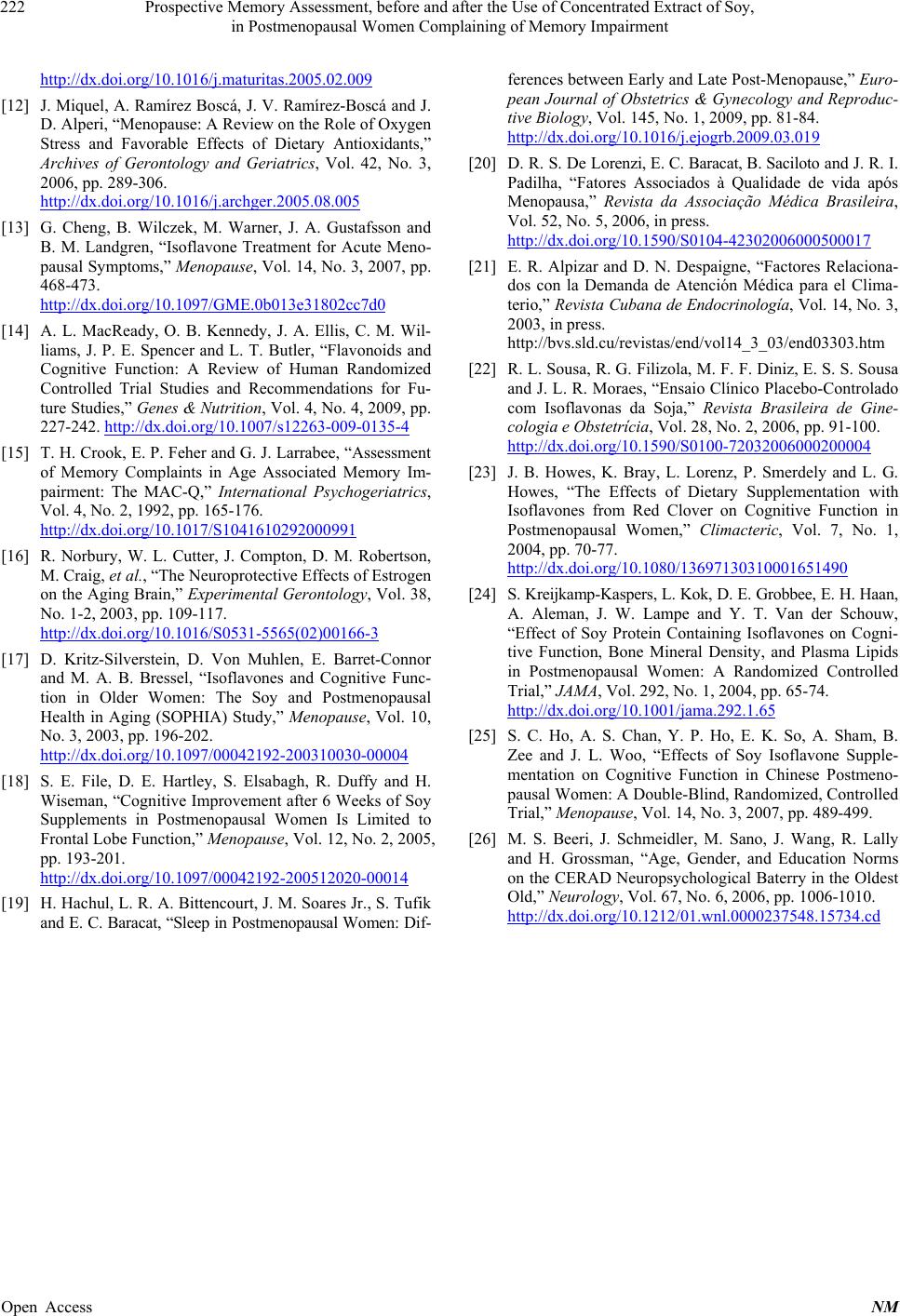 Prospective Memory Assessment, before and after the Use of Concentrated Extract of Soy, in Postmenopausal Women Complaining of Memory Impairment Open Access NM 222 http://dx.doi.org/10.1016/j.maturitas.2005.02.009 [12] J. Miquel, A. Ramírez Boscá, J. V. Ramírez-Boscá and J. D. Alperi, “Menopause: A Review on the Role of Oxygen Stress and Favorable Effects of Dietary Antioxidants,” Archives of Gerontology and Geriatrics, Vol. 42, No. 3, 2006, pp. 289-306. http://dx.doi.org/10.1016/j.archger.2005.08.005 [13] G. Cheng, B. Wilczek, M. Warner, J. A. Gustafsson and B. M. Landgren, “Isoflavone Treatment for Acute Meno- pausal Symptoms,” Menopause, Vol. 14, No. 3, 2007, pp. 468-473. http://dx.doi.org/10.1097/GME.0b013e31802cc7d0 [14] A. L. MacReady, O. B. Kennedy, J. A. Ellis, C. M. Wil- liams, J. P. E. Spencer and L. T. Butler, “Flavonoids and Cognitive Function: A Review of Human Randomized Controlled Trial Studies and Recommendations for Fu- ture Studies,” Genes & Nutrition, Vol. 4, No. 4, 2009, pp. 227-242. http://dx.doi.org/10.1007/s12263-009-0135-4 [15] T. H. Crook, E. P. Feher and G. J. Larrabee, “Assessment of Memory Complaints in Age Associated Memory Im- pairment: The MAC-Q,” International Psychogeriatrics, Vol. 4, No. 2, 1992, pp. 165-176. http://dx.doi.org/10.1017/S1041610292000991 [16] R. Norbury, W. L. Cutter, J. Compton, D. M. Robertson, M. Craig, et al., “The Neuroprotective Effects of Estrogen on the Aging Brain,” Experimental Gerontology, Vol. 38, No. 1-2, 2003, pp. 109-117. http://dx.doi.org/10.1016/S0531-5565(02)00166-3 [17] D. Kritz-Silverstein, D. Von Muhlen, E. Barret-Connor and M. A. B. Bressel, “Isoflavones and Cognitive Func- tion in Older Women: The Soy and Postmenopausal Health in Aging (SOPHIA) Study,” Menopause, Vol. 10, No. 3, 2003, pp. 196-202. http://dx.doi.org/10.1097/00042192-200310030-00004 [18] S. E. File, D. E. Hartley, S. Elsabagh, R. Duffy and H. Wiseman, “Cognitive Improvement after 6 Weeks of Soy Supplements in Postmenopausal Women Is Limited to Frontal Lobe Function,” Menopause, Vol. 12, No. 2, 2005, pp. 193-201. http://dx.doi.org/10.1097/00042192-200512020-00014 [19] H. Hachul, L. R. A. Bittencourt, J. M. Soares Jr., S. Tufik and E. C. Baracat, “Sleep in Postmenopausal Women: Dif- ferences between Early and Late Post-Menopause,” Euro- pean Journal of Obstetrics & Gynecology and Reproduc- tive Biology, Vol. 145, No. 1, 2009, pp. 81-84. http://dx.doi.org/10.1016/j.ejogrb.2009.03.019 [20] D. R. S. De Lorenzi, E. C. Baracat, B. Saciloto and J. R. I. Padilha, “Fatores Associados à Qualidade de vida após Menopausa,” Revista da Associação Médica Brasileira, Vol. 52, No. 5, 2006, in press. http://dx.doi.org/10.1590/S0104-42302006000500017 [21] E. R. Alpizar and D. N. Despaigne, “Factores Relaciona- dos con la Demanda de Atención Médica para el Clima- terio,” Revista Cubana de Endocrinología, Vol. 14, No. 3, 2003, in press. http://bvs.sld.cu/revistas/end/vol14_3_03/end03303.htm [22] R. L. Sousa, R. G. Filizola, M. F. F. Diniz, E. S. S. Sousa and J. L. R. Moraes, “Ensaio Clínico Placebo-Controlado com Isoflavonas da Soja,” Revista Brasileira de Gine- cologia e Obstetrícia, Vol. 28, No. 2, 2006, pp. 91-100. http://dx.doi.org/10.1590/S0100-72032006000200004 [23] J. B. Howes, K. Bray, L. Lorenz, P. Smerdely and L. G. Howes, “The Effects of Dietary Supplementation with Isoflavones from Red Clover on Cognitive Function in Postmenopausal Women,” Climacteric, Vol. 7, No. 1, 2004, pp. 70-77. http://dx.doi.org/10.1080/13697130310001651490 [24] S. Kreijkamp-Kaspers, L. Kok, D. E. Grobbee, E. H. Haan, A. Aleman, J. W. Lampe and Y. T. Van der Schouw, “Effect of Soy Protein Containing Isoflavones on Cogni- tive Function, Bone Mineral Density, and Plasma Lipids in Postmenopausal Women: A Randomized Controlled Trial,” JAMA, Vol. 292, No. 1, 2004, pp. 65-74. http://dx.doi.org/10.1001/jama.292.1.65 [25] S. C. Ho, A. S. Chan, Y. P. Ho, E. K. So, A. Sham, B. Zee and J. L. Woo, “Effects of Soy Isoflavone Supple- mentation on Cognitive Function in Chinese Postmeno- pausal Women: A Double-Blind, Randomized, Controlled Trial,” Menopause, Vol. 14, No. 3, 2007, pp. 489-499. [26] M. S. Beeri, J. Schmeidler, M. Sano, J. Wang, R. Lally and H. Grossman, “Age, Gender, and Education Norms on the CERAD Neuropsychological Baterry in the Oldest Old,” Neurology, Vol. 67, No. 6, 2006, pp. 1006-1010. http://dx.doi.org/10.1212/01.wnl.0000237548.15734.cd
|